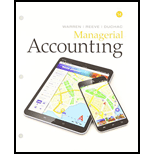
Concept explainers
Process activity analysis
The Brite Beverage Company bottles soft drinks into aluminum cans. The manufacturing process consists of three activities:
- 1. Mixing: water, sugar, and beverage concentrate are mixed.
- 2. Filling: mixed beverage is filled into 12-oz. cans.
- 3. Packaging: properly filled cans are boxed into cardboard “fridge packs.”
The activity costs associated with these activities for the period are as follows:

The activity costs do not include materials costs, which are ignored for this analysis. Each can is expected to contain 12 ounces of beverage. Thus, after being filled, each can is automatically weighed. If a can is too light, it is rejected, or “kicked,” from the filling line prior to being packaged. The primary cause of kicks is heat expansion. With heat expansion, the beverage overflows during filling, resulting in underweight cans.
This process begins by mixing and filling 6,300,000 cans during the period, of which only 6,000,000 cans are actually packaged. Three hundred thousand cans are rejected due to underweight kicks.
A process improvement team has determined that cooling the cans prior to filling them will reduce the amount of overflows due to expansion. After this improvement, the number of kicks is expected to decline from 300,000 cans to 63,000 cans, thus increasing the number of filled cans to 6,237,000 [6,000,000 + (300,000 − 63,000)].
- A. Determine the total activity cost per packaged can under present operations.
- B. Determine the amount of increased packaging activity costs from the expected improvements.
- C. Determine the expected total activity cost per packaged can after improvements. Round to three decimal places.
Want to see the full answer?
Check out a sample textbook solution
Chapter 12 Solutions
Bundle: Managerial Accounting, Loose-leaf Version, 14th - Book Only
- Can you explain this general accounting question using accurate calculation methods?arrow_forwardI need assistance with this general accounting question using appropriate principles.arrow_forwardLinnea Retail Services experienced an increase in retained earnings of $47,900 from September 30 of year 1 to September 30 of year 2. A cash dividend of $18,200 was declared and paid during the year. Compute the net income for the year.arrow_forward
- Please provide the correct answer to this general accounting problem using accurate calculations.arrow_forwardWhat is the net income percentage?arrow_forwardTata Solutions has a net income of $348,000, a profit margin of 8.7%, and an accounts receivable balance of $225,600. Assuming 80% of sales are on credit, what are the company's days' sales in receivables? (Round your answer to whole number if needed) a. 19 days b. 26 days c. 30 days d. 35 daysarrow_forward
- Please provide the accurate answer to this financial accounting problem using valid techniques.arrow_forwardI am looking for the most effective method for solving this financial accounting problem.arrow_forwardCan you explain the correct methodology to solve this general accounting problem?arrow_forward
 Managerial AccountingAccountingISBN:9781337912020Author:Carl Warren, Ph.d. Cma William B. TaylerPublisher:South-Western College Pub
Managerial AccountingAccountingISBN:9781337912020Author:Carl Warren, Ph.d. Cma William B. TaylerPublisher:South-Western College Pub Financial And Managerial AccountingAccountingISBN:9781337902663Author:WARREN, Carl S.Publisher:Cengage Learning,
Financial And Managerial AccountingAccountingISBN:9781337902663Author:WARREN, Carl S.Publisher:Cengage Learning, Cornerstones of Cost Management (Cornerstones Ser...AccountingISBN:9781305970663Author:Don R. Hansen, Maryanne M. MowenPublisher:Cengage Learning
Cornerstones of Cost Management (Cornerstones Ser...AccountingISBN:9781305970663Author:Don R. Hansen, Maryanne M. MowenPublisher:Cengage Learning Managerial Accounting: The Cornerstone of Busines...AccountingISBN:9781337115773Author:Maryanne M. Mowen, Don R. Hansen, Dan L. HeitgerPublisher:Cengage Learning
Managerial Accounting: The Cornerstone of Busines...AccountingISBN:9781337115773Author:Maryanne M. Mowen, Don R. Hansen, Dan L. HeitgerPublisher:Cengage Learning



